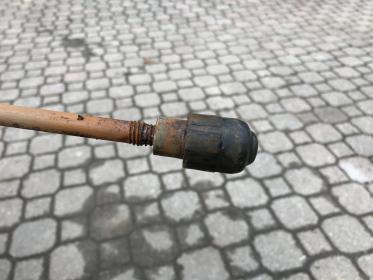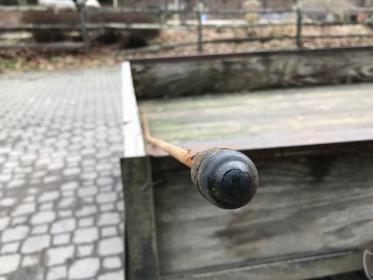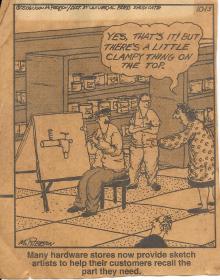Not sure if I am following you. Does it leak when a hose is not attached?
As far as the “gunk” clogging up things. preventing the rubber stopper seal at the bottom from seating/sealing properly. I doubt it. Water should be flushing any sediments out as it flows through. May if it is shut off when the hose is pressurized with and shut off at the hose end. Sediments could settle to the bottom and hang up on the seal ring in the fitting. But IMO this is a stretch. If you always shut it off at the hydrant while the water is flowing this can’t happen.
As you can see in the 2 pictures this is what the rubber stopper looks like. This part is pretty much the same used in the different brand hydrants I have installed. Looks the same as the brand you have. This is an off the shelf part the main difference between different brands is the head, handle and riser pipe rood connects.
All the hydrants I have used the riser pipe rod that the bottom seal is attached to can be adjusted. Which allows for more down pressure on the bottom stopper seal. Squeezes it tighter into the fitting.
The adjustment on this brand is easy. Loosen the set screw HP-9 on the diagram on the connector Hp-4 that the rod slides through. So as to see how much your are adjusting take a magic marker and mark the rod where it goes into the connector HP-4. With the set screw loose lift the handle a tad and look to see how much higher the connector is from your reference mark. Start with 1/8" or less. Tighten the set screw and close the handle. If you adjust too much it will be difficult to close the handle all the way. If this is the case loosen the set screw and drop the connector closer to your reference mark. Tighten and try again.
The bottom seal is just a big rubber stopper. It seats in the valve bottom HP-3. I have never had to replace this. Just the occasional adjustment. But very rarely. If the above doesn’t stop the leaking it is possible the rubber stopper is worn out, kind of hard to believe the way it is made/designed. Possible if the water has is very hard a chemical reaction has taken place and effected the rubber, hardened it. So instead of rubbery/soft it has turn very hard/solid. Never had this happen even with high iron water.
The other possibility if it still leaks, the valve bottom (HP-3) seat is defective, has developed a defect. This could happen if the hydrant is left open, pressurized, water is turned off at the end of the hose for long periods of time. Even though it is brass and shouldn’t rust a chemical reaction, calcium build up in the seat, hardened sediment etc and the rubber stopper can’t seat correctly.
If this is the case, the worst case scenario you will have to dig it up and replace that part.
Replacing the bottom seal is easy depending on on easily the head/handle comes off. This requires 2 hand tools. A big crescent wench and a big pipe wench. Can be done by one person two people makes it easier. Depends on how long, tight the head is attached to the riser pipe.
Loosen the set screw as above. The crescent wrench goes on the head, the pipe wrench on the riser pipe. This is to keep the pipe from twisting if the head is on real tight. You DON’T want to twist the riser pipe when taken the head off. This could break the supply line fitting that goes into bottom valve HP-3. Especially if a nylon/plastic elbow was used it doesn’t take much “twisting” of the riser pipe to crack this. I only use brass elbows to attach the water supply line to bottom valve.
With the head off, pull the rod out. The bottom seal is threaded and spins off the rod. Most likely you will need 2 vice grips to get this off. One to hold the rod and one on the end/head of the seal to spin it off.
Slide the rod back in and spin the head back on. Use thread tape or pipe thread putty on the rise pipe threads. Adjust the the down force as described above. Bob’s your uncle back in business. Hopefully.
The only seal I have had to replace on hydrant that have been in service for years. Is the one on the head where the rod goes through, HP-10. This seal is can and is different depending on brand. Most are just a generic O ring seal. Which can be had as most well stocked hardware stores. Esp Ag hardware stores. Just take the old one and have the match it.
The rebuilt kits have everything. But most of the stuff is unneeded, rarely needs to be replaced. But for $15 to your door can be easier than going to a hardware store. An O ring costs next to nothing. Convenience charge for the kit.
As I said the head may or may not come off easily. Murphy’s law usually kick in and it can be a PITA to spin off. Large crescent and pipe wrenches are expensive at hardware stores, home depot etc. Esp for something that is not used much by most people. This is where Harbor Freight is your friend. The pair can/should be had for under $20. IME worth the money for this job even it is only one time deal. I have found other uses for these over the years.
Good luck.
[ATTACH=JSON]{“data-align”:“none”,“data-size”:“full”,“data-attachmentid”:10285812}[/ATTACH]
[ATTACH=JSON]{“data-align”:“none”,“data-size”:“full”,“data-attachmentid”:10285813}[/ATTACH]






